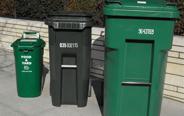One part supply, one part demand.
Reducing contamination is largely considered the starting point for creating a more stable U.S. recycling market. And that means teaching consumers what they can and cannot put in recycling bins.
For example, a triangle with a number on the bottom of a plastic container does not automatically mean it’s recyclable. Nos. 1, 2 and 5 are widely accepted in recycling programs across the country. Garden hoses and plastic bags, which can get tangled in sorting equipment, are always prohibited. Food-stained cardboard boxes are considered contamination, too.
“If our customers are saying, ‘Hey, how can I help out the economics of my current program?’ The No. 1 thing they can do is get the contamination rate down lower,” Bell said.
Waste Management is investing in machinery to better reduce contamination. Optical sorters, for instance, can identify a specific material and then use gusts of air to separate that material from the pack.
[…]
Once the sorting process is improved, the materials will need more places to go.
Large household brands are helping create these markets. PepsiCo, for instance, announced in October that it’s seeking to use 25 percent recycled content in its plastic packaging by 2025. This goal builds upon previously announced goals such as designing 100 percent of its packaging to be recyclable, compostable or biodegradable.
Such policies pressure suppliers to incorporate recycled materials if they want to keep or win that company’s business. But more brands need to take similar steps if the United States is to find uses for all the materials recycled by neighborhoods, job sites and businesses.
“There is a lot of supply and there’s not a lot of demand for the material,” said Bell of Waste Management. “We’ve got to make sure the materials that people intend to recycle every day, that we’ve got a demand for that.”
The demand for plastic pellets made from recycled materials already is robust, said Robin Waters, director of plastics planning and analysis for the research firm IHS Markit. But equipment for collecting and sorting waste needs extensive upgrades to provide the high-quality used plastic fit for making plastic resins.
Other countries are addressing this, in part, with a policy called Extended Producer Responsibility. This policy requires companies creating consumer products to pay fees for the plastic products and packaging they produce. The money collected from companies goes toward things such as upgrading recycling equipment and processing plants.
Ultimately, the fees provide incentives for companies to use less plastic, different materials or more recycled materials.
“It’s a concept that hasn’t really hit the U.S.,” Waters said, “but it will be here in five to 10 years.”
See here for some background. We need to do a lot more to reduce the amount of waste plastic. It’s going to take investment in public education and recycling infrastructure. Should have done this a long time ago, but given that we haven’t we better get started on it now.


Trump and the Republicans have set back the block at least 10 years when it comes to taking care of the planet.
If they ever build a wall they may find that it will be that it is to keep the crazy gringos out of Mexico.
What Mexico does with the bottles, https://www.washingtonpost.com/brand-studio/the-coca-cola-company/what-if-plastic-never-became-waste/
Howabout the citizens of South Texas and Northern Mexico band together and donate our plastic waste to a McAllen company that’ll take said product, melt it down and reform it into 8x8x16″ blocks (with injected resins or aggregate or ground up Budweiser cans or whatever)… then give these pallets and pallets and pallets of plastic ‘cinder’ blocks to the soldiers returning from Syria/Iraq/Afghanistan and have them start construction of that wall/not really a wall ?
#KillingTwoBirdsWithOneStone
https://www.click2houston.com/news/trash-troubles-council-passes-5m-plan-to-remedy-pick-up-problems
City of Houston hires private contractor to deal with the recycling debacle.
Manny,
Do you want to save the planet? Do you really? Then build the wall and keep Third World people in the Third World. If people come here, their carbon footprint gets much bigger, as they consume more resources….more electricity, more gasoline, more plastic, more of everything.
They need to shelter in place where they are at, where they consume less and thus contribute less to climate change.